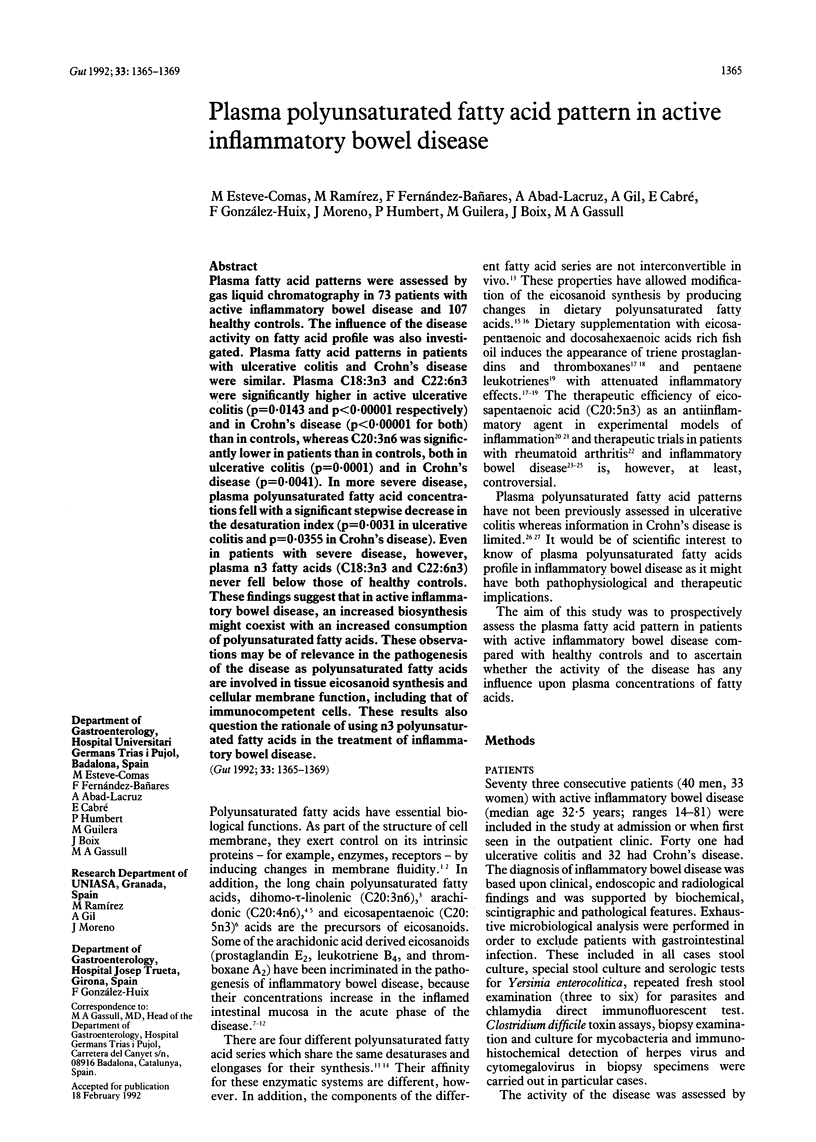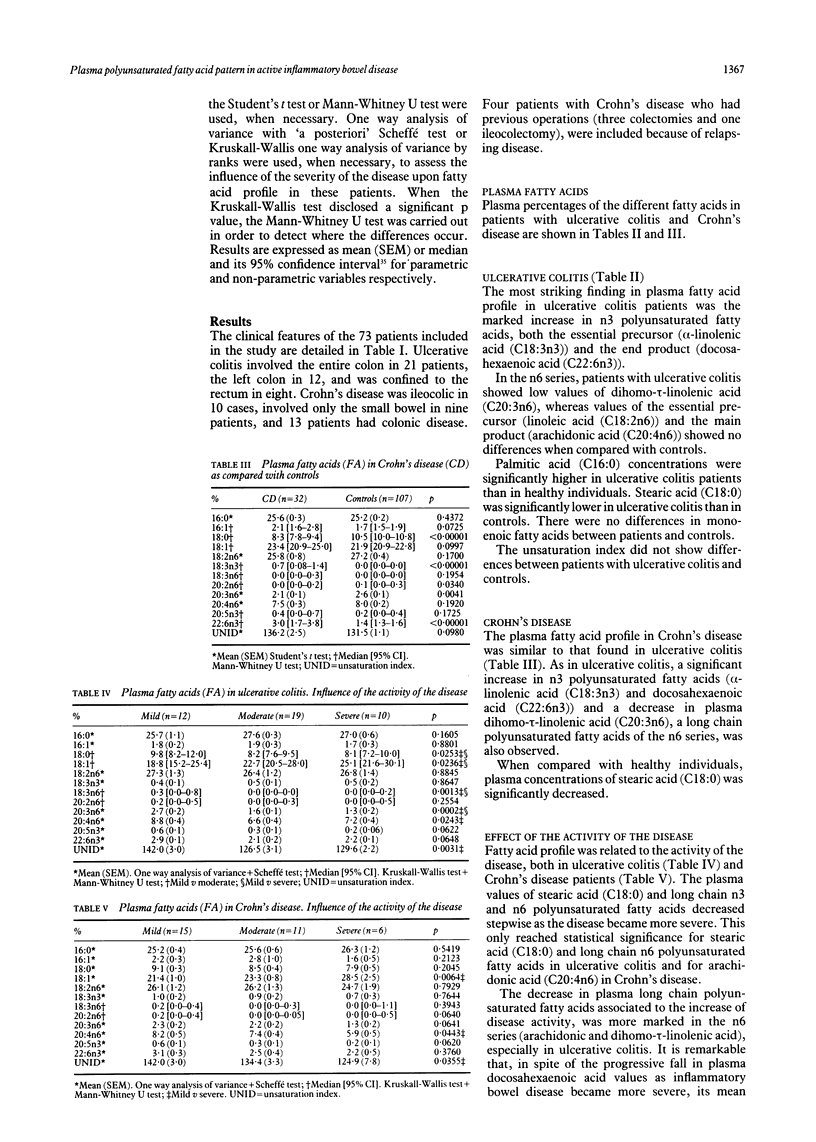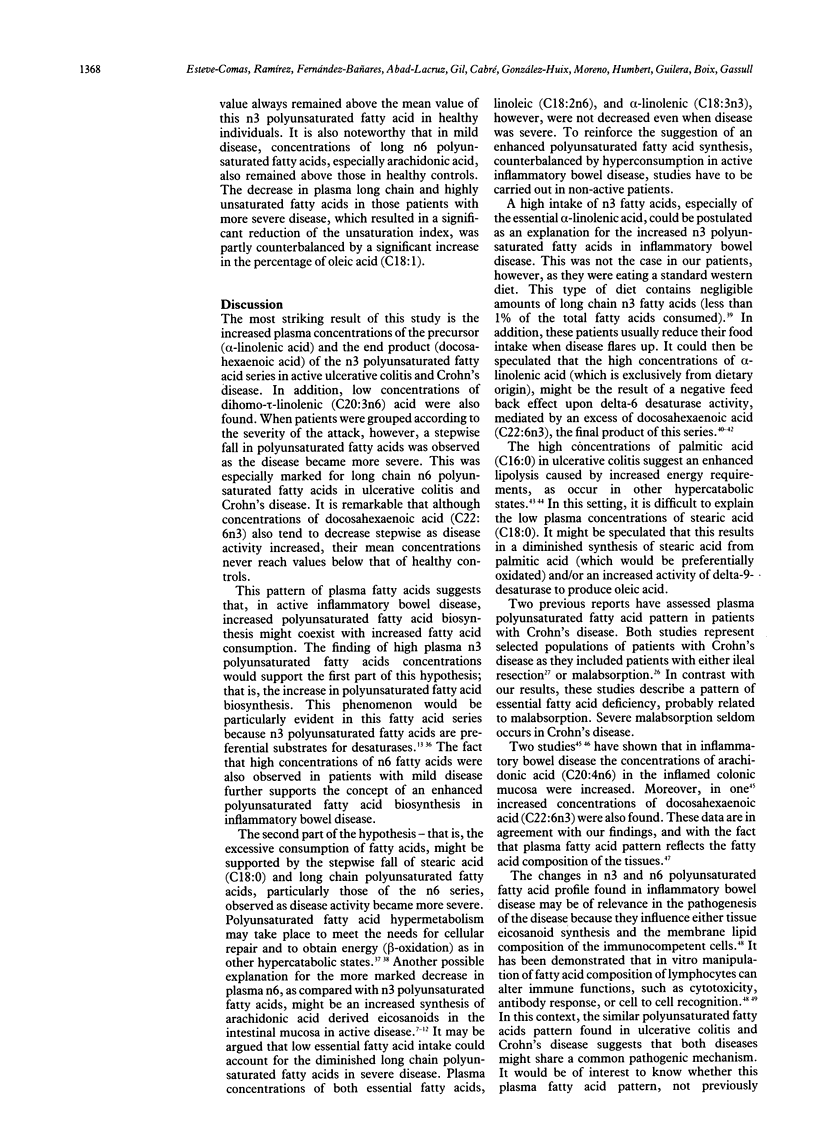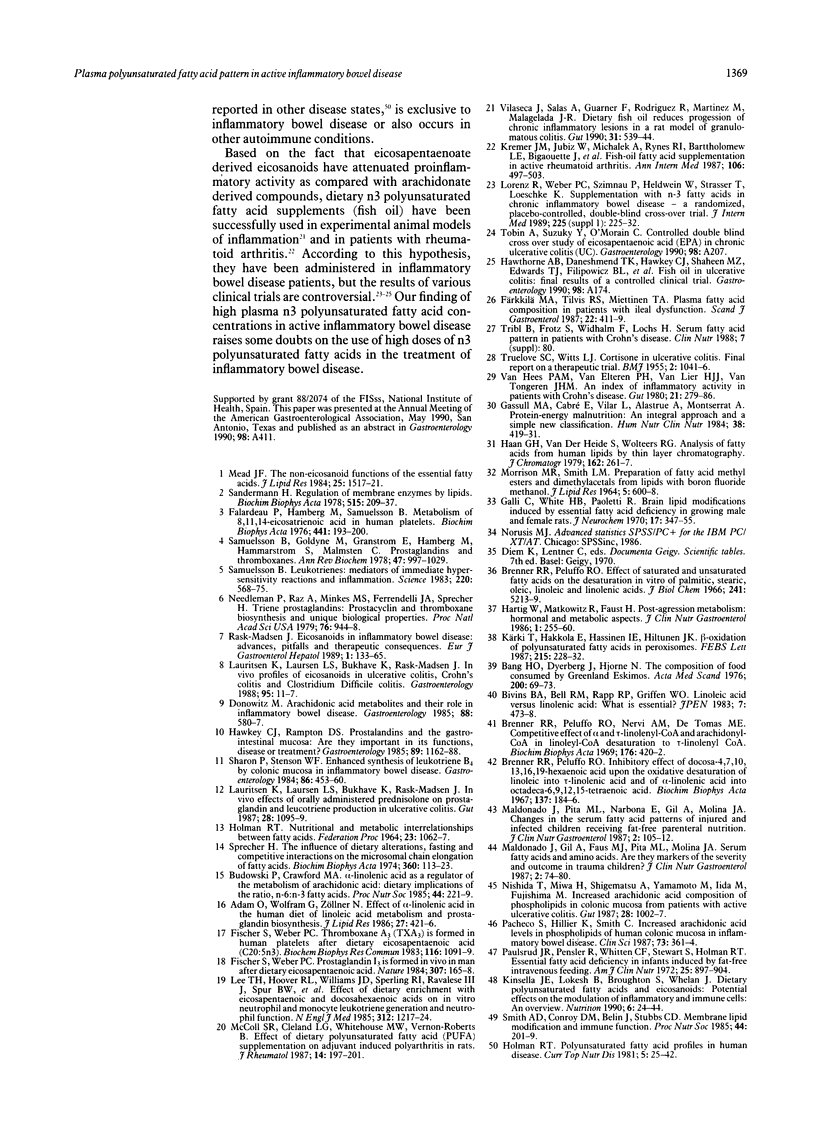Abstract
Plasma fatty acid patterns were assessed by gas liquid chromatography in 73 patients with active inflammatory bowel disease and 107 healthy controls. The influence of the disease activity on fatty acid profile was also investigated. Plasma fatty acid patterns in patients with ulcerative colitis and Crohn's disease were similar. Plasma C18:3n3 and C22:6n3 were significantly higher in active ulcerative colitis (p = 0.0143 and p < 0.00001 respectively) and in Crohn's disease (p < 0.00001 for both) than in controls, whereas C20:3n6 was significantly lower in patients than in controls, both in ulcerative colitis (p = 0.0001) and in Crohn's disease (p = 0.0041). In more severe disease, plasma polyunsaturated fatty acid concentrations fell with a significant stepwise decrease in the desaturation index (p = 0.0031 in ulcerative colitis and p = 0.0355 in Crohn's disease). Even in patients with severe disease, however, plasma n3 fatty acids (C18:3n3 and C22:6n3) never fell below those of healthy controls. These findings suggest that in active inflammatory bowel disease, an increased biosynthesis might coexist with an increased consumption of polyunsaturated fatty acids. These observations may be of relevance in the pathogenesis of the disease as polyunsaturated fatty acids are involved in tissue eicosanoid synthesis and cellular membrane function, including that of immunocompetent cells. These results also question the rationale of using n3 polyunsaturated fatty acids in the treatment of inflammatory bowel disease.
Full text
PDF




Selected References
These references are in PubMed. This may not be the complete list of references from this article.
- Adam O., Wolfram G., Zöllner N. Effect of alpha-linolenic acid in the human diet on linoleic acid metabolism and prostaglandin biosynthesis. J Lipid Res. 1986 Apr;27(4):421–426. [PubMed] [Google Scholar]
- Bang H. O., Dyerberg J., Hjøorne N. The composition of food consumed by Greenland Eskimos. Acta Med Scand. 1976;200(1-2):69–73. doi: 10.1111/j.0954-6820.1976.tb08198.x. [DOI] [PubMed] [Google Scholar]
- Bivins B. A., Bell R. M., Rapp R. P., Griffen W. O., Jr Linoleic acid versus linolenic acid: what is essential? JPEN J Parenter Enteral Nutr. 1983 Sep-Oct;7(5):473–478. doi: 10.1177/0148607183007005473. [DOI] [PubMed] [Google Scholar]
- Brenner R. R., Peluffo R. O. Effect of saturated and unsaturated fatty acids on the desaturation in vitro of palmitic, stearic, oleic, linoleic, and linolenic acids. J Biol Chem. 1966 Nov 25;241(22):5213–5219. [PubMed] [Google Scholar]
- Brenner R. R., Peluffo R. O. Inhibitory effect of docosa-4,7,10,13,16,19-hexaenoic acid upon the oxidative desaturation of linoleic into gamma-linolenic acid and of alpha-linolenic into octadeca-6,9,12,15-tetraenoic acid. Biochim Biophys Acta. 1967 Feb 14;137(1):184–186. doi: 10.1016/0005-2760(67)90024-0. [DOI] [PubMed] [Google Scholar]
- Brenner R. R., Peluffo R. O., Nervi A. M., De Thomas M. E. Competitive effect of alpha- and gamma-lionlenyl-CoA in linoleyl-CoA desaturation to gamma-linolenyl-CoA. Biochim Biophys Acta. 1969 Mar 4;176(2):420–422. [PubMed] [Google Scholar]
- Budowski P., Crawford M. A. a-Linolenic acid as a regulator of the metabolism of arachidonic acid: dietary implications of the ratio, n-6:n-3 fatty acids. Proc Nutr Soc. 1985 Jul;44(2):221–229. doi: 10.1079/pns19850041. [DOI] [PubMed] [Google Scholar]
- Donowitz M. Arachidonic acid metabolites and their role in inflammatory bowel disease. An update requiring addition of a pathway. Gastroenterology. 1985 Feb;88(2):580–587. doi: 10.1016/0016-5085(85)90525-6. [DOI] [PubMed] [Google Scholar]
- Falardeau P., Hamberg M., Samuelsson B. Metabolism of 8,11,14-eicosatrienoic acid in human platelets. Biochim Biophys Acta. 1976 Aug 23;441(2):193–200. doi: 10.1016/0005-2760(76)90162-4. [DOI] [PubMed] [Google Scholar]
- Fischer S., Weber P. C. Prostaglandin I3 is formed in vivo in man after dietary eicosapentaenoic acid. Nature. 1984 Jan 12;307(5947):165–168. doi: 10.1038/307165a0. [DOI] [PubMed] [Google Scholar]
- Fischer S., Weber P. C. Thromboxane A3 (TXA3) is formed in human platelets after dietary eicosapentaenoic acid (C20:5 omega 3). Biochem Biophys Res Commun. 1983 Nov 15;116(3):1091–1099. doi: 10.1016/s0006-291x(83)80254-x. [DOI] [PubMed] [Google Scholar]
- Färkkilä M. A., Tilvis R. S., Miettinen T. A. Plasma fatty acid composition in patients with ileal dysfunction. Scand J Gastroenterol. 1987 May;22(4):411–419. doi: 10.3109/00365528708991483. [DOI] [PubMed] [Google Scholar]
- Galli C., White H. B., Jr, Paoletti R. Brain lipid modifications induced by essential fatty acid deficiency in growing male and female rats. J Neurochem. 1970 Mar;17(3):347–355. doi: 10.1111/j.1471-4159.1970.tb02221.x. [DOI] [PubMed] [Google Scholar]
- Gassull M. A., Cabré E., Vilar L., Alastrue A., Montserrat A. Protein-energy malnutrition: an integral approach and a simple new classification. Hum Nutr Clin Nutr. 1984 Nov;38(6):419–431. [PubMed] [Google Scholar]
- HOLMAN R. T. NUTRITIONAL AND METABOLIC INTERRELATIONSHIPS BETWEEN FATTY ACIDS. Fed Proc. 1964 Sep-Oct;23:1062–1067. [PubMed] [Google Scholar]
- Haan G. J., van der Heide S., Wolthers B. G. Analysis of fatty acids from human lipids by gas chromatography. J Chromatogr. 1979 Mar 1;162(3):261–271. doi: 10.1016/s0378-4347(00)81513-3. [DOI] [PubMed] [Google Scholar]
- Hawkey C. J., Rampton D. S. Prostaglandins and the gastrointestinal mucosa: are they important in its function, disease, or treatment? Gastroenterology. 1985 Nov;89(5):1162–1188. doi: 10.1016/0016-5085(85)90225-2. [DOI] [PubMed] [Google Scholar]
- Kinsella J. E., Lokesh B., Broughton S., Whelan J. Dietary polyunsaturated fatty acids and eicosanoids: potential effects on the modulation of inflammatory and immune cells: an overview. Nutrition. 1990 Jan-Feb;6(1):24–62. [PubMed] [Google Scholar]
- Kremer J. M., Jubiz W., Michalek A., Rynes R. I., Bartholomew L. E., Bigaouette J., Timchalk M., Beeler D., Lininger L. Fish-oil fatty acid supplementation in active rheumatoid arthritis. A double-blinded, controlled, crossover study. Ann Intern Med. 1987 Apr;106(4):497–503. doi: 10.7326/0003-4819-106-4-497. [DOI] [PubMed] [Google Scholar]
- Kärki T., Hakkola E., Hassinen I. E., Hiltunen J. K. Beta-oxidation of polyunsaturated fatty acids in peroxisomes. Subcellular distribution of delta 3,delta 2-enoyl-CoA isomerase activity in rat liver. FEBS Lett. 1987 May 11;215(2):228–232. doi: 10.1016/0014-5793(87)80151-5. [DOI] [PubMed] [Google Scholar]
- Lauritsen K., Laursen L. S., Bukhave K., Rask-Madsen J. In vivo effects of orally administered prednisolone on prostaglandin and leucotriene production in ulcerative colitis. Gut. 1987 Sep;28(9):1095–1099. doi: 10.1136/gut.28.9.1095. [DOI] [PMC free article] [PubMed] [Google Scholar]
- Lauritsen K., Laursen L. S., Bukhave K., Rask-Madsen J. In vivo profiles of eicosanoids in ulcerative colitis, Crohn's colitis, and Clostridium difficile colitis. Gastroenterology. 1988 Jul;95(1):11–17. doi: 10.1016/0016-5085(88)90284-3. [DOI] [PubMed] [Google Scholar]
- Lee T. H., Hoover R. L., Williams J. D., Sperling R. I., Ravalese J., 3rd, Spur B. W., Robinson D. R., Corey E. J., Lewis R. A., Austen K. F. Effect of dietary enrichment with eicosapentaenoic and docosahexaenoic acids on in vitro neutrophil and monocyte leukotriene generation and neutrophil function. N Engl J Med. 1985 May 9;312(19):1217–1224. doi: 10.1056/NEJM198505093121903. [DOI] [PubMed] [Google Scholar]
- Lorenz R., Weber P. C., Szimnau P., Heldwein W., Strasser T., Loeschke K. Supplementation with n-3 fatty acids from fish oil in chronic inflammatory bowel disease--a randomized, placebo-controlled, double-blind cross-over trial. J Intern Med Suppl. 1989;731:225–232. doi: 10.1111/j.1365-2796.1989.tb01461.x. [DOI] [PubMed] [Google Scholar]
- MORRISON W. R., SMITH L. M. PREPARATION OF FATTY ACID METHYL ESTERS AND DIMETHYLACETALS FROM LIPIDS WITH BORON FLUORIDE--METHANOL. J Lipid Res. 1964 Oct;5:600–608. [PubMed] [Google Scholar]
- McColl S. R., Cleland L. G., Whitehouse M. W., Vernon-Roberts B. Effect of dietary polyunsaturated fatty acid (PUFA) supplementation on adjuvant induced polyarthritis in rats. J Rheumatol. 1987 Apr;14(2):197–201. [PubMed] [Google Scholar]
- Mead J. F. The non-eicosanoid functions of the essential fatty acids. J Lipid Res. 1984 Dec 15;25(13):1517–1521. [PubMed] [Google Scholar]
- Needleman P., Raz A., Minkes M. S., Ferrendelli J. A., Sprecher H. Triene prostaglandins: prostacyclin and thromboxane biosynthesis and unique biological properties. Proc Natl Acad Sci U S A. 1979 Feb;76(2):944–948. doi: 10.1073/pnas.76.2.944. [DOI] [PMC free article] [PubMed] [Google Scholar]
- Nishida T., Miwa H., Shigematsu A., Yamamoto M., Iida M., Fujishima M. Increased arachidonic acid composition of phospholipids in colonic mucosa from patients with active ulcerative colitis. Gut. 1987 Aug;28(8):1002–1007. doi: 10.1136/gut.28.8.1002. [DOI] [PMC free article] [PubMed] [Google Scholar]
- Pacheco S., Hillier K., Smith C. Increased arachidonic acid levels in phospholipids of human colonic mucosa in inflammatory bowel disease. Clin Sci (Lond) 1987 Oct;73(4):361–364. doi: 10.1042/cs0730361. [DOI] [PubMed] [Google Scholar]
- Paulsrud J. R., Pensler L., Whitten C. F., Stewart S., Holman R. T. Essential fatty acid deficiency in infants induced by fat-free intravenous feeding. Am J Clin Nutr. 1972 Sep;25(9):897–904. doi: 10.1093/ajcn/25.9.897. [DOI] [PubMed] [Google Scholar]
- Samuelsson B., Goldyne M., Granström E., Hamberg M., Hammarström S., Malmsten C. Prostaglandins and thromboxanes. Annu Rev Biochem. 1978;47:997–1029. doi: 10.1146/annurev.bi.47.070178.005025. [DOI] [PubMed] [Google Scholar]
- Samuelsson B. Leukotrienes: mediators of immediate hypersensitivity reactions and inflammation. Science. 1983 May 6;220(4597):568–575. doi: 10.1126/science.6301011. [DOI] [PubMed] [Google Scholar]
- Sandermann H., Jr Regulation of membrane enzymes by lipids. Biochim Biophys Acta. 1978 Sep 29;515(3):209–237. doi: 10.1016/0304-4157(78)90015-1. [DOI] [PubMed] [Google Scholar]
- Sharon P., Stenson W. F. Enhanced synthesis of leukotriene B4 by colonic mucosa in inflammatory bowel disease. Gastroenterology. 1984 Mar;86(3):453–460. [PubMed] [Google Scholar]
- Smith A. D., Conroy D. M., Belin J. Membrane lipid modification and immune function. Proc Nutr Soc. 1985 Jul;44(2):201–209. doi: 10.1079/pns19850039. [DOI] [PubMed] [Google Scholar]
- Sprecher H. The influence of dietary alterations, fasting and competitive interactions on the microsomal chain elongation of fatty acids. Biochim Biophys Acta. 1974 Aug 22;360(2):113–123. doi: 10.1016/0005-2760(74)90161-1. [DOI] [PubMed] [Google Scholar]
- TRUELOVE S. C., WITTS L. J. Cortisone in ulcerative colitis; final report on a therapeutic trial. Br Med J. 1955 Oct 29;2(4947):1041–1048. doi: 10.1136/bmj.2.4947.1041. [DOI] [PMC free article] [PubMed] [Google Scholar]
- Vilaseca J., Salas A., Guarner F., Rodríguez R., Martínez M., Malagelada J. R. Dietary fish oil reduces progression of chronic inflammatory lesions in a rat model of granulomatous colitis. Gut. 1990 May;31(5):539–544. doi: 10.1136/gut.31.5.539. [DOI] [PMC free article] [PubMed] [Google Scholar]
- van Hees P. A., van Elteren P. H., van Lier H. J., van Tongeren J. H. An index of inflammatory activity in patients with Crohn's disease. Gut. 1980 Apr;21(4):279–286. doi: 10.1136/gut.21.4.279. [DOI] [PMC free article] [PubMed] [Google Scholar]


